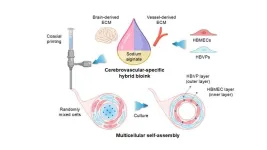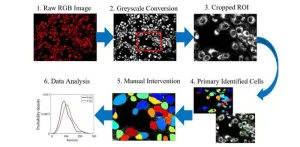(Press-News.org) Researchers at the RIKEN Center for Brain Science (CBS) have uncovered how perceptual memories linked to positive emotions, such as joy or happiness, are strengthened during sleep. The study, published in the scientific journal Neuron, could help scientists understand the neurological basis for overcoming conditions like drug or sexual addiction.
Why do emotional events, whether positive or negative, create strong, long-lasting memories of external information such as music, scene smells and textures received at the events? We know that sleep is essential for memory consolidation, the process that turns new events into memories, but do not know how it plays its role in memory enhancement. Experiments have shown that emotional events might be processed differently depending on the stage of sleep, but it is still unclear which part of sleep is more important for solidifying them, REM sleep—the time during sleep when we dream vividly—or non-REM sleep. The new study led by Masanori Murayama at RIKEN CBS set out to answer this question.
The researchers first established mouse equivalents of neutral and emotional events so that they could examine what the brain does differently during sleep when emotions are involved. In a neutral situation, male mice were allowed to explore only a smooth texture on day 1 of the experiment as a learning period and both grooved and smooth textures the next day as a testing period. When their memory of the smooth texture was kept until day 2, they preferentially explored the grooved texture, but not smooth, texture because mice innately like novel environments.
However, when the smooth texture was paired with a positive emotional experience—interaction with a female mouse—the memory of the texture lasted much longer. Even with a four-day interval, at day 5, the mice still preferred the smooth texture, showing that this experimental setup could produce emotionally enhanced texture memory in mice. As Murayama explains, “this is the first study to demonstrate perceptual memory enhancement through emotions in experimental animals. We were able to do so, and as a consequence, identified critical neural circuitry involved in perceptual memory enhancement.”
The researchers identified the amygdala, the brain’s emotional center, as key to this process. The amygdala connects to a cortical top-down circuit from motor to sensory cortices which controls accurate perception and memory of texture information, as Murayama’s group previously discovered. This tri-regional circuit strengthens emotionally linked perceptual memories. Brain recordings showed that these three brain regions were cooperatively activated in the learning periods and reactivated during early non-REM sleep, but not during REM sleep, to reinforce the memory.
To test the importance of the non-REM reactivation, the researchers temporarily prevented amygdala inputs to the motor cortex that sends top-down inputs to the sensory area. When they did this during non-REM sleep, mice failed to retain the texture memory until day 5 despite the emotional experience. In contrast, blocking the signals during REM sleep had no effect, confirming that non-REM sleep is the key sleep stage for strengthening perceptual memories.
“Traditionally, REM sleep has been thought to be the primary stage for emotional memory processing,” says Murayama. “Our findings challenge this idea and instead support non-REM sleep as the critical stage.”
This study not only explains how emotion enhances other types of memories (e.g., perception) but also points to potential treatments for conditions like addiction in which symptoms are sometimes triggered by perceptual information in a phenomenon called flashback. Such information is thought to be strongly memorized in connection with emotional events that occurred even long before the episodes. By modulating brain activity in the amygdala and related regions during non-REM sleep to weaken perceptual memories that triggers flashbacks, doctors could potentially prevent or treat addiction.
Future research will explore how these findings apply to disease models, such as age-related memory decline or addiction. “For instance, it will be important to examine whether we can recover or even strengthen memories in aged-mice,” says Murayama. “Our ultimate goal is to use this knowledge to develop treatments that improve mental health and memory-related conditions.”
END
Positive emotions plus deep sleep equals longer-lasting perceptual memories
2025-02-04
ELSE PRESS RELEASES FROM THIS DATE:
Self-assembling cerebral blood vessels: A breakthrough in Alzheimer’s treatment
2025-02-04
A 3D model accurately mimicking the Blood-Brain Barrier (BBB) in a laboratory environment has been successfully developed by research teams led by Professor Jinah Jang from the Departments of Mechanical Engineering, Life Sciences, IT Convergence Engineering, and the Graduate School of Convergence at POSTECH, and Professor Sun Ha Paek from the Department of Neurosurgery at Seoul National University Hospital. This study was recently published in Biomaterials Research, an international academic journal on materials science.
Neurodegenerative diseases, ...
Adverse childhood experiences in firstborns associated with poor mental health of siblings
2025-02-04
Children are nearly three-quarters (71%) more likely to develop mental health problems between the ages of five and 18, if the firstborn child in their family experienced adversity during their first 1,000 days, finds a new study led by UCL researchers.
The first-of-its-kind study, published in The Lancet Public Health and funded by the National Institute for Health and Care Research Policy Research Programme, found that mothers whose firstborns had experienced adverse childhood experiences had a 71% increased risk of having children (aged five -18) with mental health problems, compared to mothers whose firstborn did not experience adversity.
This ...
Montana State scientists publish new research on ancient life found in Yellowstone hot springs
2025-02-04
BOZEMAN – In a new publication in the journal Nature Communications, Montana State University scientists in College of Agriculture highlight fresh knowledge of how ancient microorganisms adapted from a low-oxygen prehistoric environment to the one that exists today. The work builds on more than two decades of scientific research in Yellowstone National Park by MSU professor Bill Inskeep.
The article, titled “Respiratory Processes of Early-evolved Hyperthermophiles in Sulfidic and Low-oxygen Geothermal Microbial Communities” was published Jan. 2. Authors Inskeep, a professor in the Department of Land Resources and Environmental Sciences, and Mensur ...
Generative AI bias poses risk to democratic values
2025-02-04
Generative AI, a technology that is developing at breakneck speed, may carry hidden risks that could erode public trust and democratic values, according to a study led by the University of East Anglia (UEA).
In collaboration with researchers from the Getulio Vargas Foundation (FGV) and Insper, both in Brazil, the research showed that ChatGPT exhibits biases in both text and image outputs — leaning toward left-wing political values — raising questions about fairness and accountability in its design.
The study revealed ...
Study examines how African farmers are adapting to mountain climate change
2025-02-03
A new international study highlights the severity of climate change impacts across African mountains, how farmers are adapting, and the barriers they face – findings relevant to people living in mountain regions around the world.
"Mountains are the sentinels of climate change,” said Julia Klein, a Colorado State University professor of ecosystem science and sustainability and co-author of the study. “Like the Arctic, some of the first extreme changes we're seeing are happening in mountains, from glaciers melting to extreme events. There's greater warming at higher elevations, so what's happening in mountains is foreshadowing what's going ...
Exposure to air pollution associated with more hospital admissions for lower respiratory infections
2025-02-03
Air pollution is a well-known risk factor for respiratory diseases such as asthma and chronic obstructive pulmonary disease (COPD). However, its contribution to lower respiratory infections —those that affect the lower respiratory tract, including the lungs, bronchi and alveoli— is less well documented, especially in adults. To fill this gap in knowledge, a team from the Barcelona Institute for Global Health (ISGlobal), a centre supported by the ”la Caixa” Foundation, assessed the effect of air pollution ...
Microscopy approach offers new way to study cancer therapeutics at single-cell level
2025-02-03
Understanding how tumors change their metabolism to resist treatments is a growing focus in cancer research. As cancer cells adapt to therapies, their metabolism often shifts, which can help them survive and thrive despite medical interventions. This process, known as metabolic reprogramming, is a key factor in the development of treatment resistance. However, current methods to study these changes can be costly, complex, and often destructive to the cells being studied. Researchers at the University of Kentucky have developed a new, simpler approach to observe these metabolic shifts in cancer cells, offering a more accessible and effective tool for cancer research.
As ...
How flooding soybeans in early reproductive stages impacts yield, seed composition
2025-02-03
FAYETTEVILLE, Ark. — With an increasing frequency and intensity of flooding events and an eye to capitalize on a common rice production technique, soybean breeders are on a quest to develop varieties with flood tolerance at any stage in the plant’s development.
Farmers who use zero-grade fields for rice as their main production system are also interested in flood-tolerant soybean varieties for crop rotation, said Caio Vieira, assistant professor of soybean breeding and a researcher for the Arkansas Agricultural Experiment Station, the University of Arkansas ...
Gene therapy may be “one shot stop” for rare bone disease
2025-02-03
For the last 10 years, the only effective treatment for hypophosphatasia (HPP) has been an enzyme replacement therapy that must be delivered by injection three-to-six times each week.
“It's been a tremendous success and has proven to be a lifesaving treatment,” said José Luis Millán, PhD, professor in the Human Genetics Program at Sanford Burnham Prebys. “Many children who have been treated otherwise would have died shortly after birth, and they are now able to look forward to long lives.
“It is, however, a very invasive treatment. Some patients have reactions from frequent injections and discontinue ...
Protection for small-scale producers and the environment?
2025-02-03
Sustainability certificates such as Fairtrade, Rainforest Alliance and Cocoa Life promise to improve the livelihoods of small-scale cocoa producers while preserving the biodiversity on their plantations. Together with the European Commission's Joint Research Centre, researchers from the University of Göttingen have investigated whether sustainability certificates actually achieve both these goals. To find out, they carried out an analysis within the Ghanaian cocoa production sector. Their results show that although certification improves both cocoa yield and cocoa income for small-scale producers, they were unable to ...








